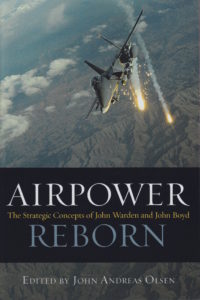 Edited by John Andreas Olsen, Naval Institute Press, Annapolis, MD (2015)
Edited by John Andreas Olsen, Naval Institute Press, Annapolis, MD (2015)
Reviewed by Colonel Curt Marsh, U.S. Marine Corps Reserve (Retired)
Airpower Reborn is an excellent update on strategic concepts and theory with an emphasis on airpower’s strategic usefulness. Although this book is a part of a new History of Military Aviation series edited by Paul J. Springer, the other books in this series are not listed (Possibly this is the first in the series). The book is primarily a compilation of articles discussing the evolution and development of strategic thought concerning the use of airpower. Emphasis is given to the more recent development of air strategy by John Boyd and John A. Warden III.
The articles (or chapters) go beyond just airpower strategy and addresses the greater topic of national strategy for any major conflict. The unique status of air power is that it provides capabilities that transcend the land or army centric constructs of the classical strategists like Clausewitz. The articles posit that airpower’s modern capabilities to provide responsive, flexible and precision weapons effects require new perspectives on developing and implementing strategies. Anyone familiar with airpower theories will recall that the early proponents of airpower have promised wonderful revolutionary results since the first use of airpower in World War I. The extravagant claims of such proponents as Jan Smuts, Giulio Douhet, Hugh Trenchard, Billy Mitchell and others famously oversold the capability of airpower to single handedly win wars. According to the editor for the book’s articles, the full capabilities of airpower finally came of age in Operation Desert Storm (1991) after disappointing for so many years.
John Boyd developed the construct of the OODA Loop as a concept of strategic decision making. OODA stands for Observe, Orient, Decide and Act. A common application of this is “rapid OODA looping” or quickly working through the OODA loop process in order to think and act faster than your opponent. The author of the chapter on Boyd and the OODA loop presents it as much more complex and insightful than this simplified “rapid” concept. He goes through a very thorough academic discussion on how the OODA loop decision making process was founded upon applied concepts from Post Modernism, Cognitive Sciences and Organizational Theory (open and closed systems). This particular chapter is a bit of an academic slog with one section titled “Neo-Darwinism, Evolutionary Epistemology, and Military Strategy” (In one sentence, he uses the word “zeitgeist” twice!). Regardless, it is an interesting review of modern organizational thought and science which is applied to methods of warfare designed to defeat an opponent through organizational and/or psychological collapse.
John A. Warden III’s chapter titled “Smart Strategy, Smart Airpower” discusses his concepts of airpower leading up to Operation Desert Storm and its application in Operation Iraqi Freedom, the invasion of Iraq. Warden was one of the key strategists for both operations including the “Shock and Awe” air campaign. He addresses Centers of Gravity and the Five Rings Model (Leadership, Processes, Infrastructure, Population and Field Forces). He also makes a great case for having an “Exit Strategy” before you ever start a war. His point here is to understand what end-state you desire before engaging in conflict, and to evaluate how successfully it may be achieved (A concept not very well applied to either Iraq or Afghanistan!).
This book is an excellent addition to your library for those who enjoy strategic analysis and theory. It should be required reading (as it may already be) at all of our service War Colleges. On a personal note, my one struggle with strategic theory is considering how to apply these concepts to our current conflicts such as with defeating ISIS. I do believe we can develop a winning strategy, but as usual the primary constraint is the political leadership. Regardless, professional military leaders need to be fully equipped to think through strategic concepts and be able to develop useful strategies for success against any opponent. Promoting winning strategies to the political class is a different issue but a skill that our senior military leaders must apply. The strategic use of airpower offers new avenues for success in warfare that the old land centric concepts of Clausewitz could never imagine.
Colonel Marsh is a naval aviator and frequent contributor to Naval History Book Reviews.

